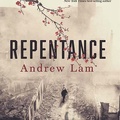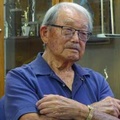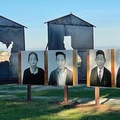Tom Okubo has had a long and successful life.
The 95 year old Sacramento man exhibits little bitterness from his experience as a former inmate of a concentration camp that imprisoned him for no reason other than his ancestry. He went on to assist in the establishment of a State Historic Monument at the site helping to preserve history.
So hopefully it will not be forgotten.
Okubo thought back to the time when as a teenager during World War II he was imprisoned at the Tule Lake War Relocation Authority Camp in Siskiyou County in a remote part of Northeastern California near the Oregon border.
The camp was a barbed-wire-enclosed guarded prison.
“I knew at the time what they (U.S. Government) were doing was wrong, but I had no choice,” Okubo said.
The Tule Lake State Historic Monument was finally realized by years of work from dedicated backers to get the site declared and to install a memorial plaque at the site by the Japanese American Citizens League (JACL) and the California Dept. of Parks and Recreation.
A National Historic Site designation was later added to the site.
Now the site faces a new threat, development from Modoc County officials who want to install an eight-foot-tall three-mile section of fence using grant money from the Federal Aviation Administration (FAA) near a rural airstrip used primarily by crop dusting airplanes.
The airstrip already occupies two-thirds of what was the former site of the Tule Lake Concentration Camp. Activists say installation of the fence will further sully the memory of the place, destroy the feeling for visiting families of former prisoners and the public attempting to recall or learn about happened here.
Opponents including the Tule Lake Committee, a historic preservation nonprofit based in San Francisco, have been fighting the fence in court for six years. Its members also oppose acquisition of the airstrip site by a Native American tribe in Oklahoma.
An environmental impact report (EIR) is being done by the fence developer and an appeal is planned in the California 9th Circuit Court of Appeals (San Francisco) by the Tule Lake Committee, challenging earlier dismissal of a lawsuit by the court.
Okubo downplays the theft by the U.S. Government of a year-and-a-half of his life by quietly saying, “It wasn’t that bad.”
In 1942 the U.S. Government decided to lock up 120,000 mostly Japanese Americans living along the West Coast even though they were U.S. citizens, depriving them of their property, jobs, and freedom. They were herded into a dozen or more camps located in remote parts of the Southwest run by the newly created War Relocation Authority (WRA).
Other camps with usually smaller populations of prisoners were managed by the U.S. Dept. of Justice (DOJ).
Okubo’s ancestors had lived in the Kochi area of Japan, a mountainous forested region on Shikoku Island, south of Tokyo. His parents immigrated to the U.S. where they took up farming in the Stockton area and Yolo County.
“I was 17, just 25 credits short of my high school diploma (Sacramento High School) when the World War II began,” Okubo said.
Okubo’s father, Yasukichi Okubo, had separated from his mother, Tamai, and returned to Japan where he would remain. That left Okubo, his mother, and younger sister Miyoko to be imprisoned in Tule Lake. He spent a year-and-a-half as a prisoner.
At Tule Lake, inmates were presented with a bumbling confusing questionnaire asking them to portray in writing their loyalty to the U.S. Those who failed to sufficiently please their captors with the questionnaire, or because of their attitude, were refused release; those who pleased officials might gain release if they had somewhere else to go, often to the Midwest including Chicago where they perhaps had family members or a waiting job.
Prisoners from other camps who failed the questionnaire or protested their imprisonment were brought to Tule Lake. The prison got a reputation as a holding pen for trouble makers.
“I relocated,” Okubo said. “I had some friends in the camp who said let’s go to Minneapolis (Minnesota) and they let me go. I got a job at a tire company working in Minneapolis for minimum wage.”
Then Okubo, who had turned 18, got drafted.
“I came back to California,” he said. “This was in 1943. I went through basic training and then was sent to Europe in the U.S. Army where I became a supply sergeant.”
Okubo said because he was of Japanese ancestry he was treated badly by a few of the soldiers in his company. However, he had a first lieutenant in the outfit who liked him.
“He (lieutenant) took me under his wing,” Okubo recalled.
Okubo stayed in Germany for a year cleaning up records in supply and then was discharged at the end of the war. He joined the reserves. In 1951 during the Korean War he was reactivated by the U.S. Army and sent to Japan where he again worked in supply.
He later returned home because his mother was ill and was discharged.
For a time he worked as a mail clerk for the State of California then attended a junior college where he worked on an accounting degree. He accepted an accounting job with the Franchise Tax Board and later the Dept. of Parks and Recreation working in the auditing section.
He retired in the 1990’s.
Okubo had been a member of the Northern California Chapter of the JACL and became involved in a project to install a state memorial monument and plaque at the site of the Tule Lake Camp. He went to help explore where the monument could be located.
“We looked at it,” Okubo said. “It wasn’t possible to put it (monument) way inside the camp site, but the California Highways (CALTRANS) had an area next to the camp (California State Highway 139).”
Okubo credited highway officials for helping get the site chosen.
The State Landmark Monument and Plaque was designed, built, and installed in 1979. Sacramento Architect Alan Oshima designed the monument. The Sacramento JACL and Northern California District of the JACL provided funding for the marker.
Okubo said a re-design later took place after it was found that adequate water runoff had not been provided and accumulating ice during the area’s frigid winters began to crack the monument.
In 2006 the site received a National Historic Landmark designation, the country’s highest recognition given to a historic site. This was described by proponents as a huge achievement.
In 2008 the Tule Lake site was included in the World War II Valor in the Pacific National Monument, one of only nine sites—the only one among 48 states in the U.S.—honoring major events during World War II. It is administered by the National Park Service.
For years the word that has been used to describe the imprisonment of Japanese Americans has been “internment.” That word almost makes the imprisonment sound legitimate, which it was not. In addition, opponents of the word “internment” said the imprisonment depriving an entire community of its freedom was based on race, not citizenship. Approximately two-thirds of the prisoners were U.S. citizens.
For that reason the WRA operated concentration camps, not internment camps, critics said.
Patty Wada, JACL regional director of the organization’s California and Western Nevada-Pacific District, said the wording on the monument plaque, describing Tule Lake as a concentration camp back in 1979, was way ahead of its time.
Okubo would agree.
“Back then (World War II) they called it a relocation center,” he said, “but I thought it was more of a concentration camp.”
© John Sammon / Nikkei West






